1976 Swedish Grand Prix race report
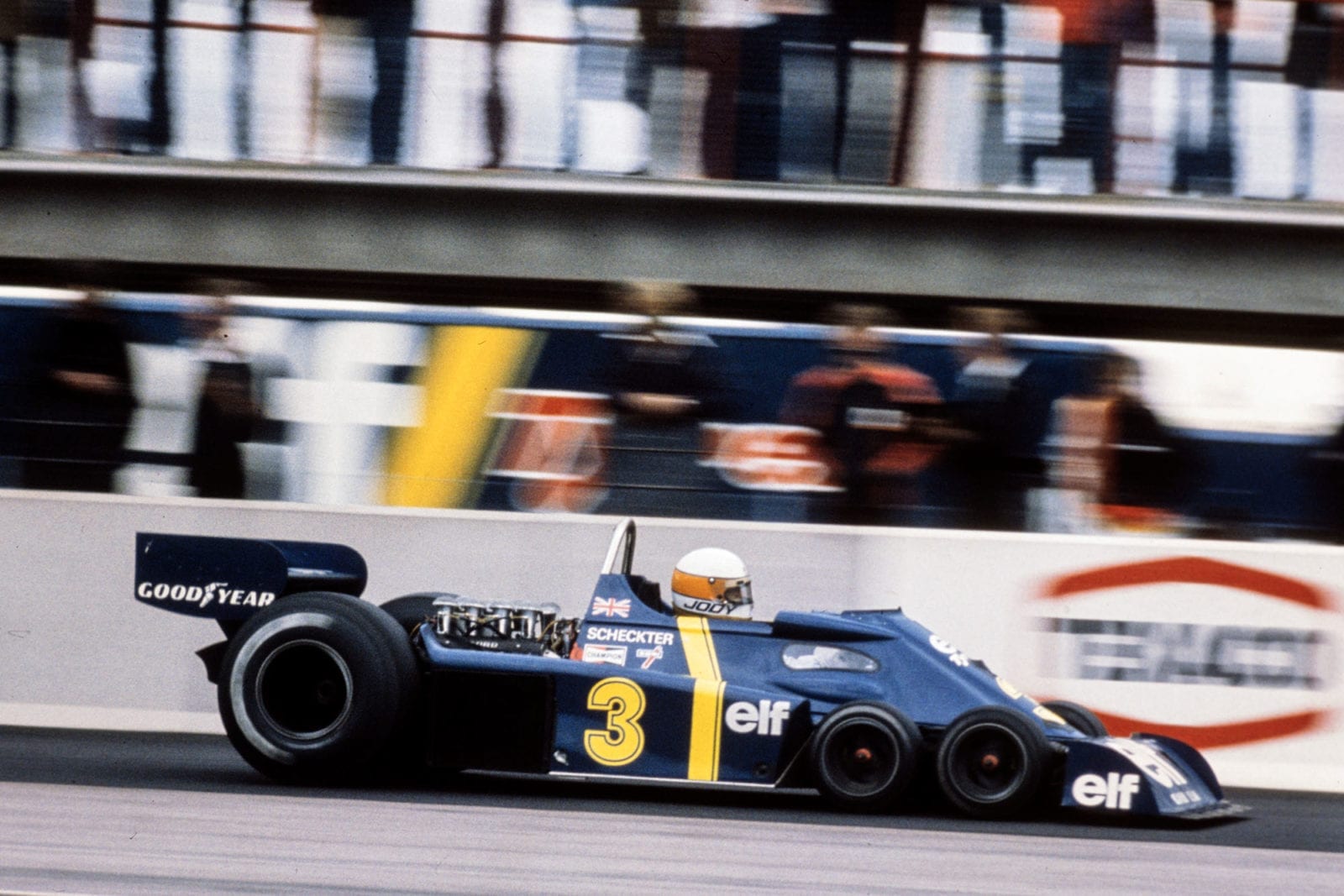
Jody Schckter took the Tyrell P34's first win
Motorsport Images
The Six-wheelers Win
Anderstorp, Sweden, June 13th
Although the manipulators behind the scenes of Formula One racing have managed to bring about a degree of uniformity to most things, almost to the point of dullness, they have yet to remove all the variety from the circuits on which the Grand Prix races are held. After the seemingly unreal atmosphere of racing round the streets of Monte Carlo, the scene moved to the totally flat and featureless geometric Scandinavian Raceway at Anderstorp in the backwoods of Sweden. You would be hard put to design a less enthralling circuit than Anderstorp, like having to fit as much Scalex track into your front room as possible. Yet, in spite of this, the atmosphere is pleasant and relaxed, everything seems spacious and enjoyable and afterwards most people say “That wasn’t a bad little Grand Prix, was it?”
At least the cars get on full song, and hold it there, on the long back straight, which is also the Flying Club’s runway, in contrast to Monte Carlo where the power is “on-off-on” all the time. The constant radius, slightly-banked corners go on for as much as 180-degrees at times and can cause some embarrassingly high G-forces to be generated. As the circuit is without any visible gradient and seems to be very smooth, it would appear that a suspension set-up almost like a Go-Kart, with no suspension at all, would work well, but somehow the reverse seems to apply. Confusion as to the real requirements for Anderstorp continues to reign and there wouldn’t be much fun for the people in Formula One racing if all the requirements were known for all the circuits. While some teams confuse themselves by trying to be scientific and logical about their approach, others take pot-luck, or adapt a “hit-and-miss” experimental attitude and when it is all done it is up to the driver anyway.
Qualifying
While some teams, like McLaren and Lotus, had paid a pre-race visit to the track for testing purposes, most of them arrived the day before first practice and everyone got stuck-in surprisingly quickly when practice began about 10.30 a.m. on Friday morning in bright sunny conditions. These days nothing can be left alone, so the chicane at the end of the runway had been re-aligned, to make it a bit tighter and slow the cars even more on to the wriggly section. It did not take long to see who was trying hard or who had come to grips with the circumstances, a slight surprise being Merzario who was fourth fastest in the initial rush and only got elbowed back to tenth fastest when the stars began to shine. There were 27 drivers practising altogether, of which only 26 would be allowed to start and the Formula One scene deserves credit for the fact that invariably everyone turns up; non-arrivals for Grand Prix practice are few and far between. As has become customary Lauda’s Ferrari was setting the pace, but was two or three seconds off last year’s practice pace, due to the tighter chicane, but equally customary the Tyrrell-twins were right behind, the six-wheelers looking beautifully balanced and controllable. Scheckter was awakening from his 1975 lethargy and was really trying, looking extremely confident and spectacular with it. The bearded Harald Ertl suddenly found himself and his Hesketh sitting amongst the scrub alongside the circuit, but managed to back out, and Tom Pryce found himself stuffed well and truly into the barriers in his Shadow, from which there was no backing out, for something had broken in the front-end causing him to crash, not a simple driving error. While Carlos Pace had been trying hard with the Brabham-Alfa Romeo, his team-mate Reutemann was held up by gear selection bothers which were eventually traced to distortion of the gearbox end cover over the selector mechanism.
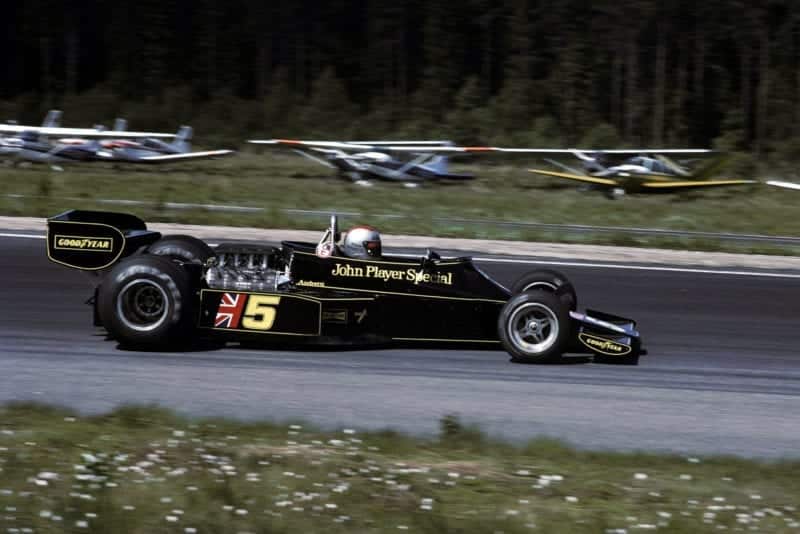
Mario Andretti secured 2nd on the grid for Lotus
Motorsport Images
There was an enforced break in the practice while the breakdown lorry collected the bent Shadow and Pryce, who was quite unhurt, prepared to carry on in the spare car. In the McLaren team Hunt was not too happy with the feel of his usual car M23/8, so when practice restarted he went off in the spare car, M23/6 and found it more to his liking. Michael Leclere tried the Hesketh-Williams car, but it made little difference to his position near the bottom of the grid and the other two rear runners, Kessel and Nellemann in the RAM Racing Brabham-C,osworths both faded away on the circuit with minor troubles. Scheckter was really pressing on in the six-wheeled Tyrrell as was Depailler and joining them to show that Lauda and Ferrari can be beaten was Mario Andretti in the Lotus 77. At Zolder there had been signs that Andretti and Colin Chapman were getting to grips with the sorting-out of the new Lotus and before practice at Anderstorp had begun the little USAC driver had expressed satisfaction with the car and confidence that he would be “up there with them” no matter who “them” were. While some teams were having minor troubles, and others were having major ones, Scheckter had a hilarious one. Leaving the chicane the tiny little left-front/ front wheel parted company from his Tyrrell and the first he knew was a slight twitch of the car as of getting a puncture. He looked through the left-hand window of the cockpit surround and saw a stationary brake-disc and no wheel! As the car is quite stable (at slower speeds, of course) on five wheels, he drove back to the pits and his mechanics gathered round the cockpit to see what he wanted, only to find him laughing his head off inside his Bell helmet, for none of them had noticed the tiny wheel was missing; then one of them looked down! There was no serious damage done and the car was soon raceworthy again.
The whole hour and a half had seemed to generate an air of frenzy as if it was the last chance to qualify for a good grid position, but amidst it all the little Ensign team were getting along nicely, and Chris Amon was driving very neatly and smoothly on his first visit to the Swedish track and finished up fifth fastest, just behind Lauda who was behind the Tyrrell/Lotus/Tyrrell sandwich. Next fastest was Peterson, the extra paint on his March by reason of the First National Bank sponsorship not affecting his performance. In an attempt to approach Anderstorp scientifically the Peterson March was using an enormously long wheelbase, brought about by a giant spacer between the engine and gearbox, which was actually the gearbox casing from the old central-gearbox 721X, but was empty except for the shaft joining the flywheel to the Hewland input shaft. Moving the whole rear assembly back had brought an unseen problem with overheating, for the sidemounted water radiators rely on air turbulence immediately ahead of the rear wheels to induce crossflow, but now the turbulence had moved back with the wheels and no longer reached the radiators which were still in their same positions alongside the engine. This problem was solved during the lunch break by reverting to short wheelbase by removing the spacer and bringing the gearbox and rear wheels forward to their normal position. The other March-A car had a more fundamental problem, for the engine had broken which had stopped Brambilla’s practice, but many March mechanics’ hands soon had another engine installed and the car was ready for the afternoon practice. The lunch break was also used by the Penske mechanics to weld stiffening plates on the front pick-up points Of the top rear radius arms on the new Penske, and while the job was being finished off Watson re-commenced practice with the spare car PC3/02. Regazzoni was another driver who used the team’s spare car in the afternoon practice, as his regular car did not feel good under braking, so it was put aside for attention later.
A driver who would have liked his team to have had a spare car was Gunnar Nilsson, and they would have done so had not their new car destroyed itself in pre-race testing. As it was his regular car 77/R2, just would not run properly due to the German Rita ignition system playing up and before the afternoon session was over the car was wheeled back into the paddock for serious investigation to take place. While Lauda had asserted himself with his normal position at the front his team-mate Regazzoni was still in trouble, returning to the pits with oil pouring from a loose union under the engine. No damage was done and it was soon put right, but it wasted valuable time. In the Brabham pits Pace was complaining bitterly to the Alfa Romeo designer Carlo Chiti about the oil all over the back of the car and on the inboard brakes, but the cause was not a simple loose union as on the flat-12 cylinder Ferrari; Chiti seemed to suggest that oiliness was a design feature of the flat-12 Alfa Romeo engine!
When the pandemonium subsided and the electronic timing aparatus fed all its information into the computer system the result of the afternoon efforts was that Lauda was fastest, Andretti was second, Amon third, Scheckter fourth, Depailler fifth and Laffite in the Ligier-Matra sixth. The only alteration with the combined times for the day was that Depailler moved his six wheeler up into third place, the other positions remaining the same. On Saturday morning the weather was rather cool and dull, though dry enough, and the hour and a half of practice was supposed to be devoted to doing tests with full petrol tanks, and to scrubbing in sets of tyres ready, for race day. This is in accordance with a bright idea thought up by the Goodyear tyre technicians and the constructors little mouthpiece. In actual fact most people carry on experimenting with handling adjustments to try and improve their times, even though there is no official time-keeping taking place, or they are trying to beat insuperable problems like making an engine rev properly or a gearbox select its gears properly. Actual race preparation does not enter into the thoughts of many teams for there is still the final hour of timed practice to come and the last chance to get a good grid position or even get on the grid at all for the tail-enders. The frenzy and pandemonium seemed as pronounced as ever, though Laffite was bedding in a new Matra engine and gearbox on the Ligier, and Scheckter tried his Tyrrell with the sausage-like air collector box, though by and large most people were beginning to abandon air collector boxes, preparing to let the engine suck air in as best it could and let the air flow over the car have more effect on the rear aerofoil. While Scheckter was charging round, Reutemann was unhurriedly going along in his Brabham-Alfa Romeo and as the six-wheeler overtook the Brabham it chopped in a bit too soon and the fat rear wheels clipped the front of the Brabham and spun it into a concrete retaining wall, so there was a pause while the wreckage was collected and the two drivers gave an explanation of their unruly behaviour to the Stewards. Reutemann had banged his right hand rather badly and was not too keen to continue practice, even though the Brabham mechanics had the spare car ready for him. Merzario would have liked to continue practising but the left rear corner of his March was torn apart as a hub bearing had broken up and was being replaced.
In the final hour the tempo became even more frenzied and Scheckter and Depailler were forcing ahead with their six-wheelers, the handling being such as to give them great confidence to let the whole car slide through the corners in a graceful, balanced and spectacular style. In complete contrast was the Ensign which Amon was driving with studied neatness and precision, and achieving the same results. Lauda’s Ferrari engine was getting a bit tired, a new one being due to be fitted for the race, and he could not get near the front, ending up in fifth place, but still ahead of 22 others. Andretti was really in the Anderstorp groove and heading for the front when all the teeth stripped off third gear pinion in the Hewland gearbox. In spite of everything being very hot the Lotus mechanics tore the gearbox apart, cleaned out the broken bits, fitted new gears and Andretti was back in the fray, repaying their efforts with second fastest time overall and a place on the front row of the grid. The other Lotus was in as much trouble, for though a complete engine change had got it going properly, a joint in the front suspension collapsed and Nilsson lost a lot of time while it was replaced. At this point he was still down amongst the rabbits at the back of the field, but then just before it was too late everything started to work right and he did a superb fast lap which moved hint right up into sixth place; and then the Lotus ran out of petrol. You can’t think of everything when there is a panic on.
Reutemann resumed practice rather disconsolately in the spare Brabham-Alfa Romeo after having the Ferrari-like nose piece taken off and the original one fitted, which meant hack-sawing off the new mounting framework, and Pryce was not as confident with the spare Shadow as he had been before his accident. Jochen Mass had the lower rear aerofoil on his McLaren off and on and decided to leave it on, while Hunt seemed to be spinning every time you looked up, the McLaren being quite unable to keep its back wheels under control. Alan Jones was trying as hard as he could with the works Surtees, but getting no real results, possibly because he was trying too hard, and poor Emerson Fittipaldi was back down with the also-rans, the Copersucar-sponsored car not responding to chassis-tuning the way they wanted it to. Frank Williams was wondering why he had got such a large and opulent set-up to achieve twenty-fifth place overall when Morris Nunn with no set-up or entourage at all had his car in third place overall, operating from the back of what looked like a secondhand furniture van compared to the Walter Wolf Racing transporter, motor-home and support vehicles. Frank Williams was not the only one looking sideways at the red Ensign on the second row of the grid, with its Valvoline sticker on the side and the name of some completely unknown property development company as well.
When it was all over it was not surprising that the Danish driver Jac Nellemann, having his first dabble in Formula One, was the odd man out, and it was interesting that no-one had dominated practice. Depailler had been fastest in the first session, Lauda in the second and Scheckter in the third, but we have had enough races and practice now to see that Ferrari versus the six-wheelers is the format, with cheeky intervention by the Ensign and a welcome return of Lotus to the front. The earlier demise of Team Lotus to the back of the grid just wasn’t real. The Ligier-Matra V12 is always well in the running, the March teams have spasms of excitement, the McLaren team are still wondering how i-inch oversize on width could possibly have made all that difference, and if the Brabham-Alfa Romeos are ever going to get anywhere to justify the size of the operation they had better hurry up because the season is halfway over. The back-markers are still the back-markers and there is no real reason why they should change.
Race
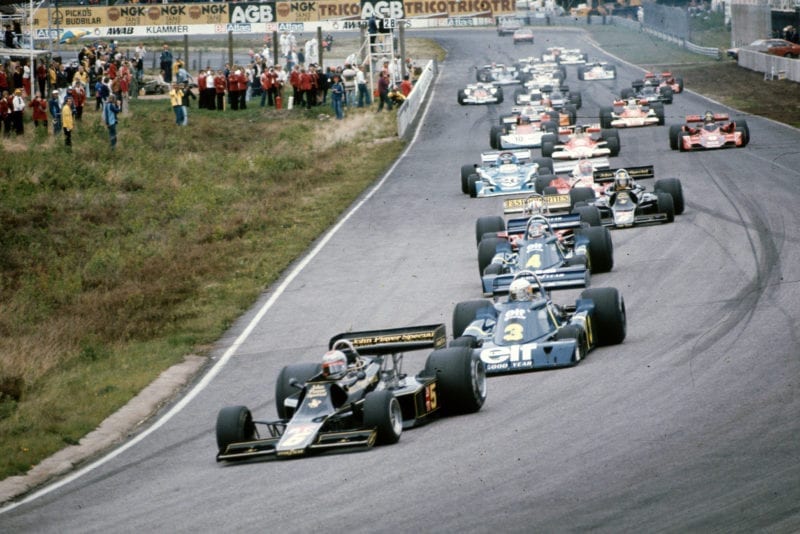
Andretti leads at the race start
Motorsport Images
Race day was cool and cloudy, but quite dry, and after the Swedish airforce had tried to emulate the Red Arrows and there had been a few diversions and parades to keep the 33,000 paying customers happy, 1.30 p.m. aproached and the serious business of the 72-lap race drew near. All one and three-quarter hours of it. While the cars were being warmed-up Colin Chapman and his engineers were measuring the overall balance of Nilsson’s car, fore-and-aft and side-to-side, to say nothing of corner-to-diametric-corner and Chapman decided it was “undriveable like that”. Then everyone went off on a warm-up lap and lined up in grid formation in front of the pits, which are at one end of the circuit. The starting-line and time-keepers are at the other end, half–a-lap away, so when everyone was ready Scheckter and Andretti on the front row led them away round to the start, followed by Amon and Depailler, and then Lauda and Nilsson. With the two-by-two grid layout these days, and 26 cars taking part those at the back can barely see the starting flag (when there is one). This time the tail-enders were still rounding the corner at the beginning of the starting straight when Scheckter and Andretti reached the starting line. The Swedish flag trembled and everyone hung with back wheels spinning furiously on the slippery surface. With his Cosworth V8 bouncing on the rev-limiter at 11,500 r.p.m. Andretti snatched second gear and the black and gold Lotus leapt into the lead as the others found grip and chased after him to the first corner.
While the Swedish Ferrari Owners Club looked puzzled at seeing the cars of Lauda and Regazzoni in amongst the pack, the Lotus owners in the crowd thought “this is like old times”. As the field poured round the 150-degree curve by the pits the order was Andretti, Scheckter, Depailler, Amon, Nilsson, Lauda and Laffite, but out of the back-markers shot the new Penske with its throttle jammed open by dust and grit on the slides. and as Watson scrabbled to switch everything off the car bounded over an earth hank and almost into the crowd, bent and battered and out of the race. Meanwhile Reutemann peeled off, into the pits, his engine sounding anything but sweet. Along the runway sped the slim little Lotus, with the two six-wheelers in hot pursuit and at the end of the opening lap there was no change among the front runners. However, in the organisation there was some clucking and chuntering and the start-line judges, Allan Parsson and Gustav Larsson, decided that Andretti had jumped the start and they penalised him one minute, as if it was a Formula Ford race. This information was transmitted to Colin Chapman at the pits who signalled “-58 sec.” to Andretti as he went by steadily pulling out a lead. He thought “Is Colin nuts?” for he could see Scheckter two seconds behind in his mirrors as he went along the runway straight. Next time the signal read “Start Pen” and the little Italian thought “.. . those dumb Swedes . . .” As there was little point in worrying about it, or even wondering if he could make up a minute on Scheekter or anyone else who got into second place he decided to “. . . win the race and sort it out afterwards”. Naturally none of his opponents knew about the penalty and few people in the pits heard the loudspeaker announcement with the continual roar of the passing cars. One thing they all did know was that Gunnar Nilsson was not racing any more, for on the third lap he spun out of the right-angle corner before the pits and cannoned backwards into the pit wall, so there was no need for expianations to his team, he had landed almost at their feet. The other Swedish hero, Ronnie Peterson, was not doing anything stupid but he wasn’t exciting the crowd, being in eighth place behind Hunt.
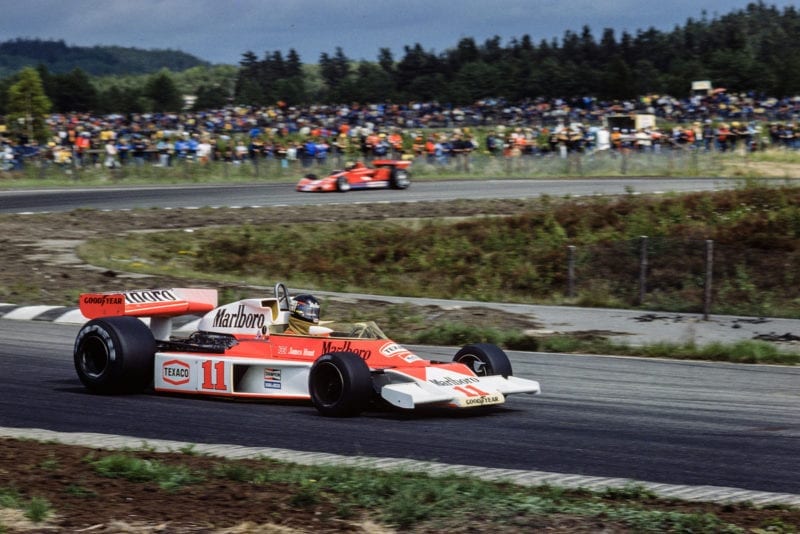
McLaren’s James Hunt managed a 5th place finish
Motorsport Images
Reutemann gave up as his right hand was hurting him and he felt there was no point in being brave and heroic in last place, and Kessel spun off with the rough on lap 6. Fittipaldi had achieved some sort of handling for his car by removing the front anti-roll bar altogether, but the result was that the front tyres wore out so rapidly that there was no point in going on. Ferrari enthusiasts had maintained that if the fresh engine in Lauda’s car was going to make any difference he would be in the lead in five laps. He wasn’t in the lead by ten laps, and it was obvious that he never would be while those in front kept going. Andretti was waiting for no-one, nor was he stopping to argue about his penalty, Scheckter was sliding the Tyrrell through the corners beautifully but not quite keeping the gap constant. Depailler was still third, and Amon fourth and then came Lauda driving as hard as he could, but it wasn’t enough. Quite a gap had opened up before Laffite went by leading a nose-to-tail string of eleven cars, in the order Hunt, Peterson, Pace, Regazzoni, Brambilla, Mass, Jarier, Pryce, Jones, Merzario and Stuck. Bringing up the rear were Leclerc, Perkins, and Lunger, and Ertl had made a pit stop after going offthe road.
Gradually the scene at the front spread out, with equal gaps between the first five cars, while Laffite pulled the Ligier-Matta well ahead of Hunt. The Hesketh of Ertl got in the way of the following bunch when they came to lap him as it was faster than most down the straight, but slower through the wiggly bits. By twenty laps the high-speed procession was very settled and it was just a matter of seeing who was going to break down first. The number had already been reduced by one when the Dutch-owned Ensign burst its engine at the chicane, leaving Perkins with a long walk home. Andretti was looking so smooth and comfortable out in front that it seemed that nothing could stop him, certainly not the six-wheeled Tyrrells, or the Ferraris and everyone felt that Amon and the Ensign should not have been there in fourth place, while a lot of people wished it wasn’t.
Amon, however, was enjoying himself and could see no reason why he should not have third place as he was gradually catching Depailler. A cloud of dust went up as Branshills got in a muddle while braking for the pits corner and took to the rough stuff, but it did not delay him and he kept his place behind Regazzoni. The March nose cowling was decidedly tatty on the right side after this, and on right-hand bends the air was getting under the nose and upsetting the balance, so Brambilla gradually dropped back. Merzario could not understand why those in front of him were going so slowly, so he livened things up by passing Pryce, Jarier and Mass and then set off after Brambilla.
Just over half distance as a lethargic air was pervading the scene a very large cloud of dust at the first corner after the start indicated that something pretty serious had happened. Anion had Depailler in his sights when the left front corner of the Ensign collapsed And the car went head-on into the barriers after knocking down two catch-fences. A very shaken New Zealander climbed out of the wreckage with bruised legs and was very lucky to be uninjured. While the Ensign crash at Zolder had happened too quickly for Amon to know what had happened, this one had gone on for a long time in his full view. While this had been taking place there was a stir going on in the pits for Ken Tyrrell had been trying to find out whether the minute penalty on Andretti was official, and Race Control at the pits end of the circuit could not get any sense out of the control point at the start-line. Until he knew officially he was not going to signal Scheckter or Depailler, so that as far as they were concerned they were still trying to catch the Lotus, though in vain. What they didn’t know was that the Lotus Cosworth VS engine had lost its edge and Andretti was trying to give it an easy time and had been doing so for ten or fifteen laps, which was why his lead had not been increasing. As the Lotus finished lap 45 it was slowing visibly and as it approached the pits end of the circuit on lap 46 a gusher of oil blew out of one of the inlet trumpets as a piston broke up and the whole thing went by the pits in a cloud of smoke and that was that. Looking out of Race Control, waiting for confirmation of the minute penalty, Tyrrell said “Don’t bother” and returned to his pit to urge his lads to take it easy and concentrate on completing the remaining laps.
In first and second places the revolutionary six-wheeled Tyrrells, brain-children of Derek Gardner, cruised round in complete control in only their fourth Grand Prix, so that any “doubting Thomases, Michaels or Leonards” must have felt a bit uncomfortable. Given that they only inherited those places because the Lotus engine blew up, it did not alter the fact of being first and second, even if it was by luck, and behind them were thirteen other cars that would have liked some of that “luck”, Lauda was comfortably in third place, though somewhat dejected, and Laffite was very content in fourth place, equally secure. In fifth place was Hunt, hut he had Peterson closing up on him, and in seventh place Pace had Regazzoni closing up on him, the Ferrari driver obviously becoming conscious of the fact that one of the “hopeless Alfa Romeo-engined” cars was ahead of his all-conquering Ferrari. In ninth place was the struggling Brambilla in the orange March and behind him, waving his fist, was Merzario in the white March. Pryce, Mass, Jarier, Jones, I.unger, Stuck and Ertl had all been lapped.
With everything to lose and so much to gain Scheckter drove on tip-toe, trying as hard as he could not to strain the engine, the clutch, the gearbox, the brakes or the suspension, for it only wanted one little thing to go wrong to spoil it all. Apart front Stuck retiring at the pits, Ertl spinning off again, erratically this time, and Merzario’s engine giving out right at the end, the Swedish Grand Prix ran its course and the two six-wheeled Tyrrells finished in perfect order in first and second places. The Ferrari team were not at all happy with their third place nor with Regazzoni, even though he did pass Pace, and Peterson for good measure, while a lot of people would have been very happy to have finished third, or even sixth. It was interesting that Regazzoni’s Ferrari went by Peterson’s March on the long straight as if it was standing still, but could make no ground at all on Hunt’s McLaren on the same straight.
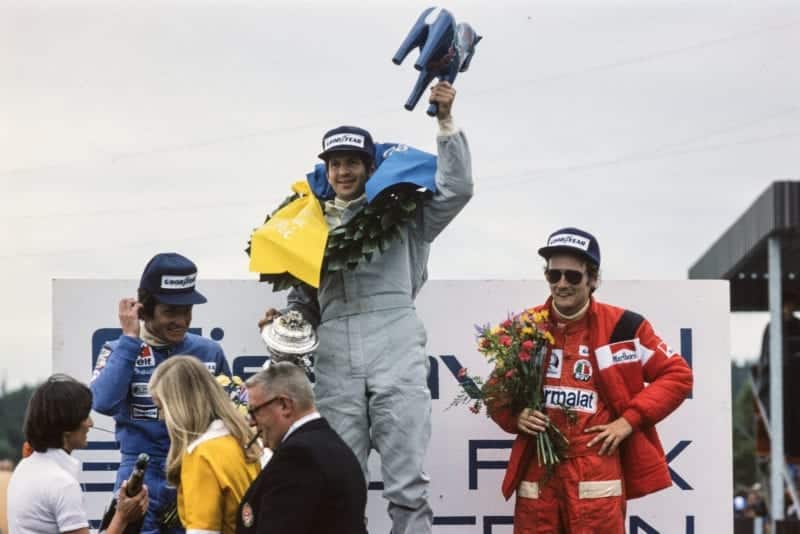
Scheckter celebrates a famous first win for his Tyrrell six-wheeler
Motorsport Images
The Swedish weekend was wound up with a lot of questions being asked and few answers given, but with everyone looking forward to the next Grand Prix which is on the Paul Ricard circuit, which has a lot in common with Anderstorp. Principally it has the same ability of not producing much in the way of emotional driving or racing. There were a lot of familiar faces missing from Sweden, notably Ferrari’s chief engineer, Mauro Forghieri; the Lotus Team Manager Peter Warr; some of the “Union officials” from the “Trade and Industry” and the FIA; quite a lot of the “eyes and ears of the world” and, of course, the BRM team, but no-one noticed that. Whether the rising or falling fortunes of the various factions had anything to do with absentees is only a matter of conjecture.—D.S.J.
